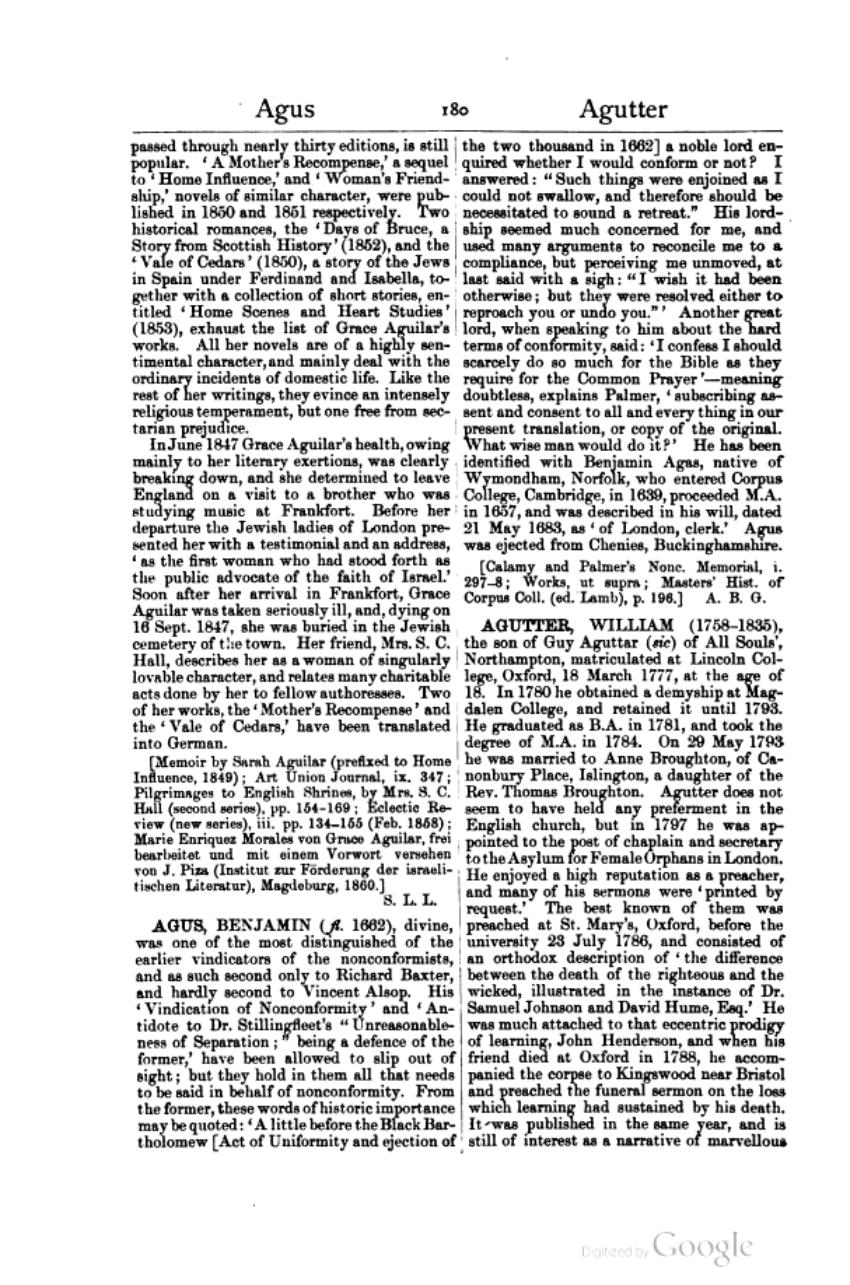passed through nearly thirty editions, is still popular. ‘A Mother's Recompense,’ a sequel to ‘Home Influence,’ and ‘Woman's Friendship,’ novels of similar character, were published in 1850 and 1851 respectively. Two historical romances, the ‘Days of Bruce, a Story from Scottish History’ (1852), and the ‘Vale of Cedars’ (1850), a story of the Jews in Spain under Ferdinand and Isabella, together with a collection of short stories, entitled ‘Home Scenes and Heart Studies’ (1853), exhaust the list of Grace Aguilar's works. All her novels are of a highly sentimental character, and mainly deal with the ordinary incidents of domestic life. Like the rest of her writings, they evince an intensely religious temperament, but one free from sectarian prejudice.
In June 1847 Grace Aguilar's health, owing mainly to her literary exertions, was clearly breaking down, and she determined to leave England on a visit to a brother who was studying music at Frankfort. Before her departure the Jewish ladies of London presented her with a testimonial and an address, ‘as the first woman who had stood forth as the public advocate of the faith of Israel.’ Soon after her arrival in Frankfort, Grace Aguilar was taken seriously ill, and, dying on 16 Sept. 1847, she was buried in the Jewish cemetery of the town. Her friend, Mrs. S. C. Hall, describes her as a woman of singularly lovable character, and relates many charitable acts done by her to fellow authoresses. Two of her works, the ‘Mother's Recompense’ and the ‘Vale of Cedars,’ have been translated into German.
[Memoir by Sarah Aguilar (prefixed to Home Influence, 1849); Art Union Journal, ix. 347; Pilgrimages to English Shrines, by Mrs. S. C. Hall (second series), pp. 154–169; Eclectic Review (new series), iii. pp. 134–155 (Feb. 1858); Marie Enriquez Morales von Grace Aguilar, frei bearbeitet und mit einem Vorwort versehen von J. Piza (Institut zur Förderung der israelitischen Literatur), Magdeburg, 1860.]
AGUS, BENJAMIN (fl. 1662), divine, was one of the most distinguished of the earlier vindicators of the nonconformists, and as such second only to Richard Baxter, and hardly second to Vincent Alsop. His ‘Vindication of Nonconformity ’ and ‘Antidote to Dr. Stillingfleet's “Unreasonableness of Separation;” being a defence of the former,’ have been allowed to slip out of sight; but they hold in them all that needs to be said in behalf of nonconformity. From the former, these words of historic importance may be quoted: ‘A little before the Black Bartholomew [Act of Uniformity and ejection of the two thousand in 1662] a noble lord enquired whether I would conform or not? I answered: “Such things were enjoined as I could not swallow, and therefore should be necessitated to sound a retreat.” His lordship seemed much concerned for me, and used many arguments to reconcile me to a compliance, but perceiving me unmoved, at last said with a sigh: “I wish it had been otherwise; but they were resolved either to reproach you or undo you.”’ Another great lord, when speaking to him about the hard terms of conformity, said: ‘I confess I should scarcely do so much for the Bible as they require for the Common Prayer’—meaning doubtless, explains Palmer, ‘subscribing assent and consent to all and every thing in our present translation, or copy of the original. What wise man would do it?’ He has been identified with Benjamin Agas, native of Wymondham, Norfolk, who entered Corpus College, Cambridge, in 1639, proceeded M.A in 1657, and was described in his will, dated 21 May 1683, as ‘of London, clerk.’ Agus was ejected from Chenies, Buckinghamshire.
[Calamy and Palmer's Nonc. Memorial, i. 297–8; Works, ut supra; Masters' Hist. of Corpus Coll. (ed. Lamb), p. 196.]
AGUTTER, WILLIAM (1758–1835), the son of Guy Aguttar (sic) of All Souls', Northampton, matriculated at Lincoln College, Oxford, 18 March 1777, at the age of 18. In 1780 he obtained a demyship at Magdalen College, and retained it until 1793. He graduated as B.A. in 1781, and took the degree of M.A. in 1784. On 29 May 1793 he was married to Anne Broughton, of Canonbury Place, Islington, a daughter of the Rev. Thomas Broughton. Agutter does not seem to have held any preferment in the English church, but in 1797 he was appointed to the post of chaplain and secretary to the Asylum for Female Orphans in London. He enjoyed a high reputation as a preacher, and many of his sermons were ‘printed by request.’ The best known of them was preached at St. Mary's, Oxford, before the university 23 July 1786, and consisted of an orthodox description of ‘the difference between the death of the righteous and the wicked, illustrated in the instance of Dr. Samuel Johnson and David Hume, Esq.’ He was much attached to that eccentric prodigy of learning, John Henderson, and when his friend died at Oxford in 1788, he accompanied the corpse to Kingswood near Bristol and preached the funeral sermon on the loss which learning had sustained by his death. It was published in the same year, and is still of interest as a narrative of marvellous
